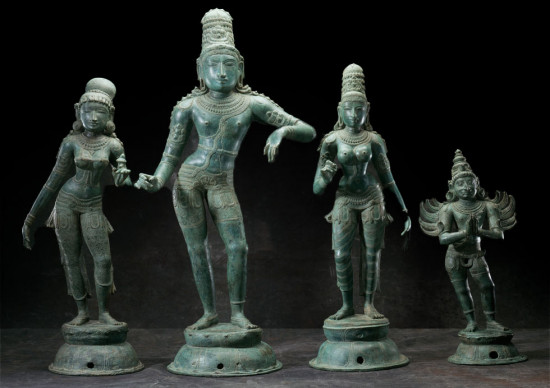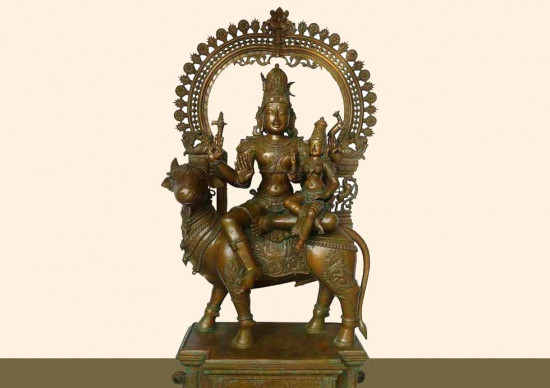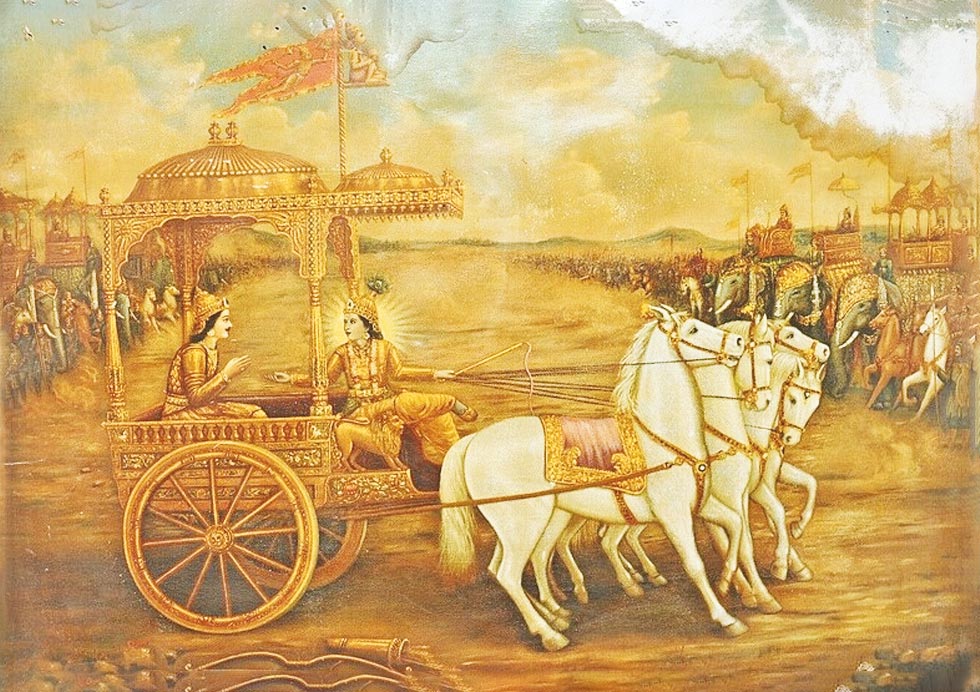
The Bhagavad Gita is a 700-verse Hindu scripture that is part of the Mahabharata epic. The Gita is a dialogue between the warrior-prince Arjuna and his charioteer Krishna, who is an incarnation of the God Vishnu. In the Gita, Krishna imparts spiritual knowledge to Arjuna and helps him to overcome his doubts and fears about the impending battle.
The Gita is one of the most important and influential texts in Hinduism. It has been translated into many languages and is studied by Hindus all over the world. The Gita is a source of spiritual guidance and inspiration for Hindus of all walks of life.
The story of the Gitopadesam took place on the day of the Kurukshetra War. The vast plains of Kurukshetra were about to be stained with the blood of battle. The huge armies of the Pandavas and Kauravas faced each other, divided by family ties and fueled by old resentments. At their head was Arjuna, the Pandava prince known for his skill with the bow. But on this fateful day, his heart was not filled with the spirit of battle but with deep doubt.
Arjuna looked at the ranks of soldiers, seeing familiar faces. Cousins he grew up with, respected teachers, even close friends, now stood ready to fight against each other. The reality of fighting loved ones crushed Arjuna’s resolve.
Dharma, the sacred duty that guided everyone, weighed heavily on him. He knew the Pandavas had been wronged and driven from their kingdom by their deceitful cousins. Fighting was the only way to reclaim their justice. But how could he justify this righteous cause with the thought of killing those he cared about?
The burden was too much to bear. Arjuna sank to his knees, his chariot, driven by Lord Krishna, his charioteer and confidant, stopped amidst the preparations. Tears streamed down his face, reflecting his inner turmoil. With a trembling voice, he questioned the meaning of the conflict.
“Krishna,” he pleaded, “Why fight against our own kin? What glory is there in a victory bought with the blood of brothers?”
The Gita is one of the most important and influential texts in Hinduism. It has been translated into many languages and is studied by Hindus all over the world. The Gita is a source of spiritual guidance and inspiration for Hindus of all walks of life.
The story of the Gitopadesam took place on the day of the Kurukshetra War. The vast plains of Kurukshetra were about to be stained with the blood of battle. The huge armies of the Pandavas and Kauravas faced each other, divided by family ties and fueled by old resentments. At their head was Arjuna, the Pandava prince known for his skill with the bow. But on this fateful day, his heart was not filled with the spirit of battle but with deep doubt.
Arjuna looked at the ranks of soldiers, seeing familiar faces. Cousins he grew up with, respected teachers, even close friends, now stood ready to fight against each other. The reality of fighting loved ones crushed Arjuna’s resolve.
Dharma, the sacred duty that guided everyone, weighed heavily on him. He knew the Pandavas had been wronged and driven from their kingdom by their deceitful cousins. Fighting was the only way to reclaim their justice. But how could he justify this righteous cause with the thought of killing those he cared about?
The burden was too much to bear. Arjuna sank to his knees, his chariot, driven by Lord Krishna, his charioteer and confidant, stopped amidst the preparations. Tears streamed down his face, reflecting his inner turmoil. With a trembling voice, he questioned the meaning of the conflict.
“Krishna,” he pleaded, “Why fight against our own kin? What glory is there in a victory bought with the blood of brothers?”
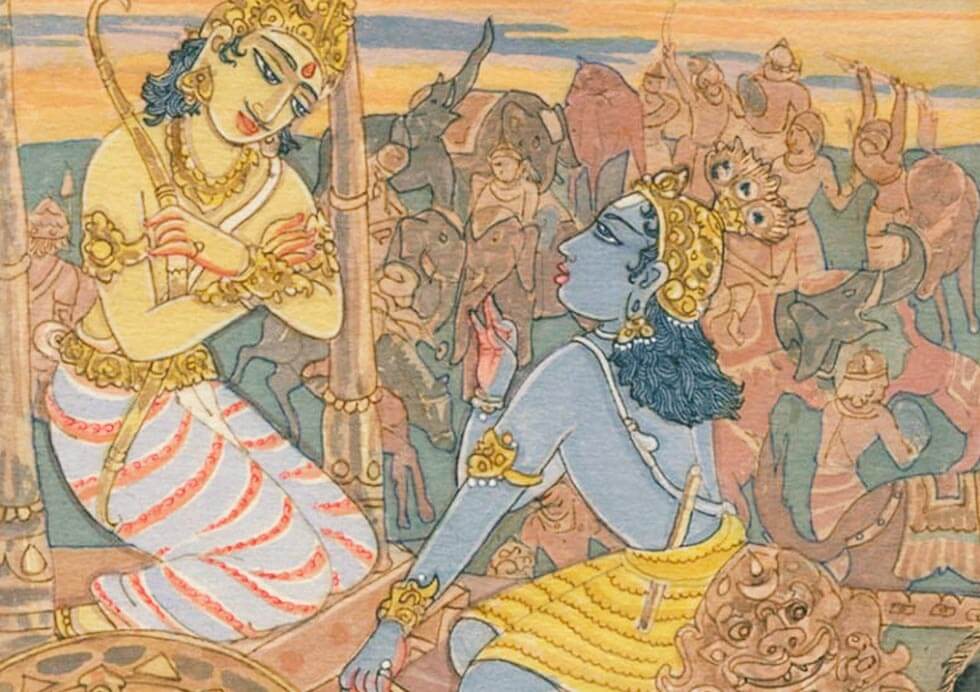
In that moment of crisis, the stage was set for the profound teachings at the heart of the Bhagavad Gita. Krishna, embodying the divine, became Arjuna’s guide, explaining the mysteries of dharma (duty), karma (action), and the true nature of the self. He led Arjuna from despair to the brink of enlightenment.
Arjuna sought Krishna’s guidance. Krishna spoke of the soul’s nature, the cycle of birth and death, and the path to liberation. He also revealed his divine form to Arjuna, showing him the true nature of reality.
With gentle authority, Krishna explained the path to liberation—selfless devotion and unwavering commitment to one’s duty. By performing actions as offerings to the divine, one could be freed from karma’s chains and the illusions of material life.
Arjuna sought Krishna’s guidance. Krishna spoke of the soul’s nature, the cycle of birth and death, and the path to liberation. He also revealed his divine form to Arjuna, showing him the true nature of reality.
With gentle authority, Krishna explained the path to liberation—selfless devotion and unwavering commitment to one’s duty. By performing actions as offerings to the divine, one could be freed from karma’s chains and the illusions of material life.
As Krishna taught, Arjuna’s understanding deepened. He saw the profound truth beyond the battlefield’s chaos. Then, in a moment of divine revelation, Krishna showed his true cosmic form “Vishwaroopam” to Arjuna. This vision, encompassing the universe, revealed the interconnectedness of all life and the divine essence of reality.
Through Krishna’s guidance and the vision of his divine form, Arjuna’s eyes were opened to the mysteries of existence. He gained clarity about his purpose and the timeless truths that go beyond personal struggles and fleeting desires. In that transformative moment, Arjuna glimpsed the ultimate reality—the eternal essence underlying the ever-changing world.
यदा यदा हि धर्मस्य ग्लानिर्भवति भारत।
अभ्युत्थानमधर्मस्य तदात्मानं सृजाम्यहम् ॥४-७॥
परित्राणाय साधूनां विनाशाय च दुष्कृताम् ।
धर्मसंस्थापनार्थाय सम्भवामि युगे युगे ॥४-८॥
Explanation:
This verse is from the Bhagavad Gita. In this verse, Krishna explains that he incarnates on Earth whenever there is a decline in dharma and an increase in adharma. He does this to protect the good, destroy the wicked, and reestablish dharma.
The word “dharma” has a complex meaning that encompasses righteousness, duty, morality, and law. It is the opposite of “adharma,” which means unrighteousness, iniquity, and lawlessness.
Krishna’s statement in this verse reflects the Hindu belief in a cyclical view of history. According to this view, history is divided into four ages, or yugas, each of which is characterized by a decline in dharma. At the end of each yuga, Krishna incarnates to restore dharma and usher in a new age.
This verse also teaches the importance of dharma in Hindu thought. Dharma is not just a set of rules or laws, but a way of life that is based on righteousness, compassion, and justice. It is the path that leads to liberation from the cycle of birth and death.
Through Krishna’s guidance and the vision of his divine form, Arjuna’s eyes were opened to the mysteries of existence. He gained clarity about his purpose and the timeless truths that go beyond personal struggles and fleeting desires. In that transformative moment, Arjuna glimpsed the ultimate reality—the eternal essence underlying the ever-changing world.
यदा यदा हि धर्मस्य ग्लानिर्भवति भारत।
अभ्युत्थानमधर्मस्य तदात्मानं सृजाम्यहम् ॥४-७॥
परित्राणाय साधूनां विनाशाय च दुष्कृताम् ।
धर्मसंस्थापनार्थाय सम्भवामि युगे युगे ॥४-८॥
Explanation:
This verse is from the Bhagavad Gita. In this verse, Krishna explains that he incarnates on Earth whenever there is a decline in dharma and an increase in adharma. He does this to protect the good, destroy the wicked, and reestablish dharma.
The word “dharma” has a complex meaning that encompasses righteousness, duty, morality, and law. It is the opposite of “adharma,” which means unrighteousness, iniquity, and lawlessness.
Krishna’s statement in this verse reflects the Hindu belief in a cyclical view of history. According to this view, history is divided into four ages, or yugas, each of which is characterized by a decline in dharma. At the end of each yuga, Krishna incarnates to restore dharma and usher in a new age.
This verse also teaches the importance of dharma in Hindu thought. Dharma is not just a set of rules or laws, but a way of life that is based on righteousness, compassion, and justice. It is the path that leads to liberation from the cycle of birth and death.
The Gita is a complex and profound text that has been interpreted in many different ways. However, its central message is that we should all strive to live a life of dharma, or righteousness. We should do our duty without attachment to the fruits of our actions. We should also cultivate detachment from the material world and focus on the spiritual.
The Gita is a timeless and universal text that offers guidance and inspiration to people of all faiths. It is a source of wisdom and strength that can help us to overcome our challenges and live a more meaningful life.
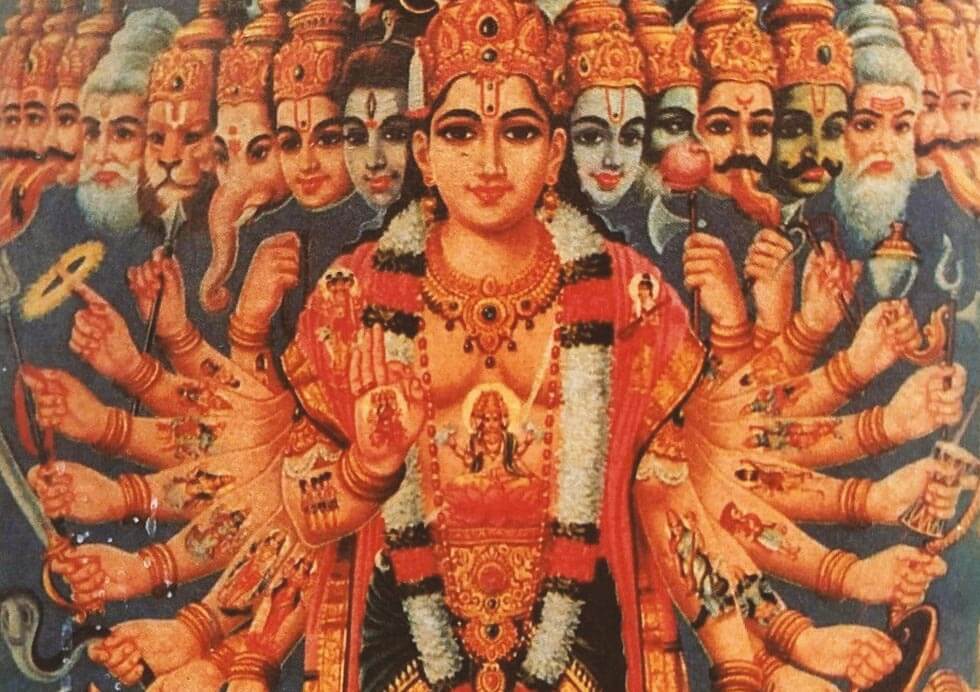
Here are Some of The Key Teachings of The Bhagavad Gita:
The soul is eternal and indestructible.
Eternal Soul: Imagine yourself not as a physical body, but as an unchanging spark of consciousness, untouched by birth or death. This spark, the Gita teaches, is your true self, eternal and indestructible.
The cycle of birth and death is caused by karma.
Karma’s Cycle: Our actions (karma) leave imprints on this soul, influencing our future lives. Like seeds, good karma blossoms as happiness, bad as suffering. Liberation breaks free from this cycle, leading to lasting peace.
The path to liberation is through dharma, or righteousness.
Dharma’s Path: Following your righteous duty (dharma) helps burn off negative karma and guides you towards liberation. Dharma isn’t just blind obedience, but acting in harmony with your true nature and contributing to the greater good.
We should do our duty without attachment to the fruits of our actions.
Action without Attachment: Do your duty, strive for your goals, but don’t cling to the outcome. Success or failure are just temporary experiences, not reflections of your worth. By letting go of attachment, you avoid karmic burden and inner turmoil.
We should cultivate detachment from the material world and focus on the spiritual.
Spiritual Focus: The material world, with its fleeting pleasures and pains, is ultimately an illusion. Cultivating detachment allows you to focus on eternal reality, your true self, and the path to liberation.
The Bhagavad Gita is a profound and inspiring text that can offer guidance and support to people of all faiths. It is a source of wisdom and strength that can help us to overcome our challenges and live a more meaningful life.

